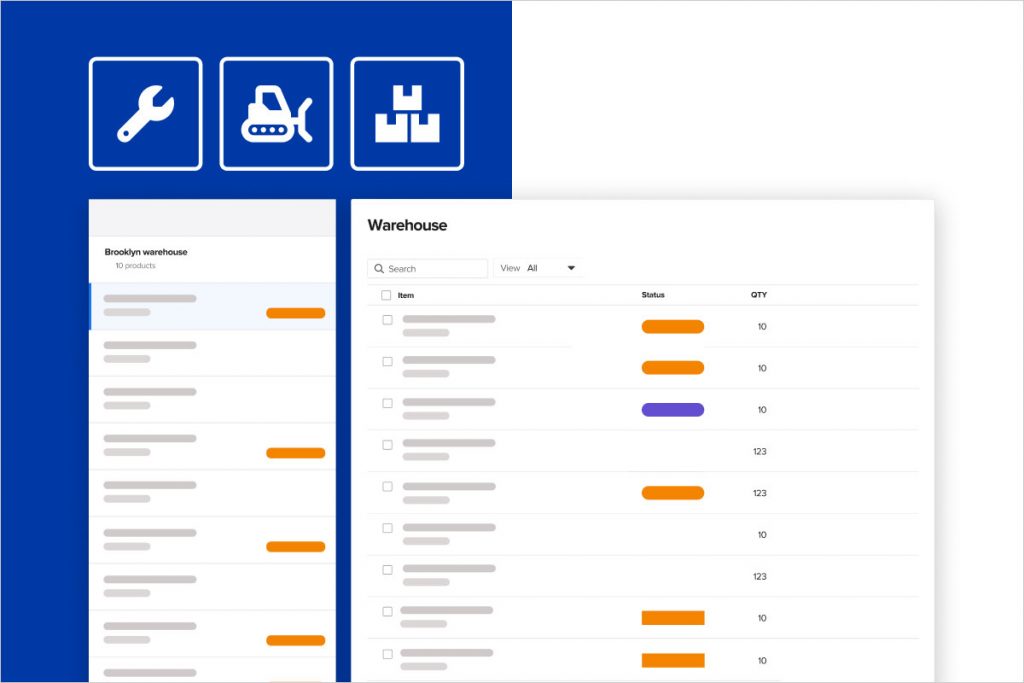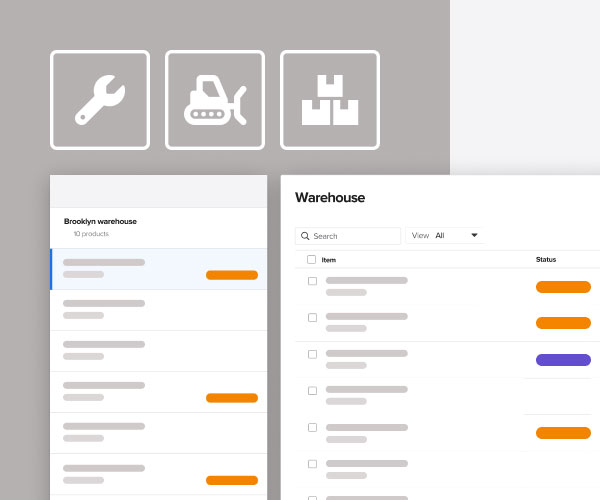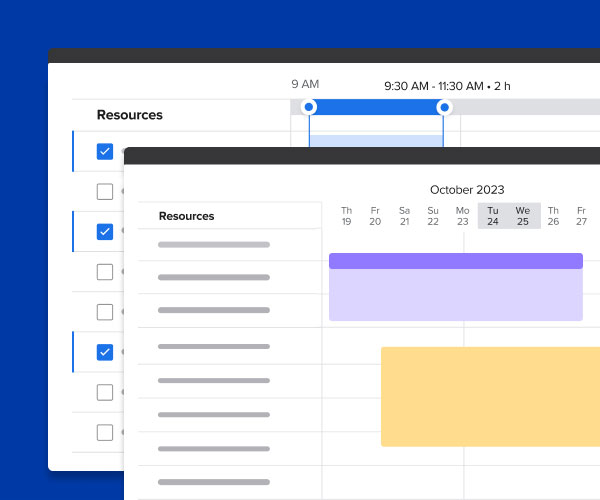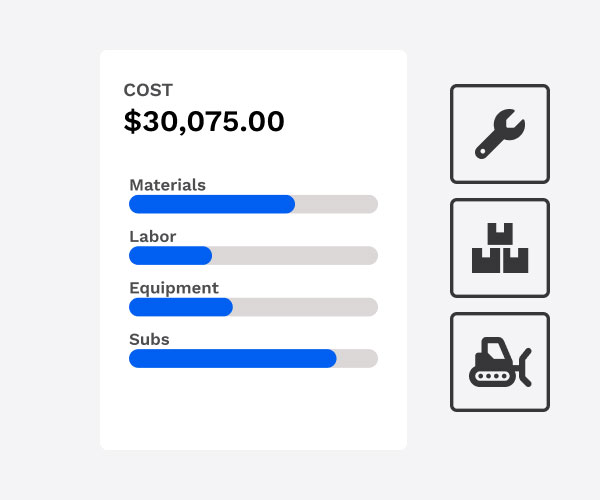CONSTRUCTION Equipment management software
Keep track of every piece of equipment
Knowify’s equipment management lets you manage your equipment inventory, assign to specific departments, and track costs over time in a streamlined and organized way.

Keep track of your equipment no matter the quantity
Whether you’re managing a small team, or multiple teams of 30, your equipment is a significant investment you need to protect.
- Track every piece of equipment with an easy-to-use platform you can access from anywhere.
- Ensure your team is equipped with the tools and machines they need to do their work efficiently.


Know where each piece of equipment belongs
Always know where your equipment needs to go, and which team is responsible for it.
- Assign your machinery to specific departments or roles within your company to document ownership and responsibilities.
- Easily review assignments and where equipment is located so you know which piece belongs at which job site.
Rented or owned, track the cost of your equipment usage
Whether you rent or own your equipment, accounting for its cost is the only way to ensure proper job costing and accurate margins on every job.
- Ensure you’re properly tracking all incurred costs during a project by assigning an hourly rate for each piece of equipment whether it’s rented or owned.
- Never forget to track equipment costs as they’re automatically applied to the job and phase where you assign them.

“Knowify supports my goals and expectation to provide a superb customer experience for my clients.”
Erin Polson
Owner, Polson Painting
Build your business with confidence
Add, assign, and properly track your equipment – try Knowify free for 14 days, and see how easy it is to keep your tools organized and your teams on task!
FAQs
What is equipment management in construction?
Equipment management is an umbrella term that covers acquiring, maintaining, scheduling, and disposing of equipment. Construction is a very broad industry, so equipment could mean everything from heavy machinery to trade-specific tools to standard equipment you might rent like a lift.
The main goals of equipment management are to ensure your team has the equipment they need to complete a project efficiently and safely, control costs related to owning and renting equipment, and ensure equipment is well maintained.
How do you organize construction equipment?
Your approach to organization will be unique to your business, but in general, Knowify recommends categorizing and tracking each piece of equipment, treating equipment as an employee with an hourly rate (covers usage of equipment, maintenance, depreciation, etc.), that’s assigned to a team and then scheduled to jobs or job phases. Maintain a record of hours used on the job site and track that actual cost against your budgeted cost.
What is equipment management software?
Equipment management software helps you maintain an inventory of your equipment, track its usage on the job site, organize maintenance records, and allow you to schedule equipment to a job as needed.
What are the key features and benefits of equipment management software?
When selecting the best equipment management software for your organization, it’s essential to consider the key features and benefits that will meet your specific needs. Here are some of the most critical features to look for:
- Equipment tracking: The ability to track equipment location, usage, and maintenance history in real-time ensures you always know where your assets are and how they are performing.
- Maintenance scheduling: Automated scheduling of preventive maintenance tasks helps reduce downtime and increase the lifespan of your equipment.
- Work order management: Streamlined creation, assignment, and tracking of work orders ensure efficient maintenance operations and quick resolution of issues.
- Asset management: Comprehensive management of equipment assets, including depreciation, warranty, and maintenance records, provides a complete overview of your equipment lifecycle.
- Reporting and analytics: Detailed reports and analytics offer insights into equipment performance, usage, and maintenance costs, aiding in informed decision-making.
The benefits of implementing a robust equipment management software include:
- Improved productivity: Increased efficiency and reduced downtime through automated maintenance scheduling and work order management.
- Cost savings: Reduced maintenance costs through preventive maintenance and extended equipment lifespan.
- Enhanced decision-making: Data-driven insights into equipment performance and usage to inform maintenance planning and asset management decisions.
- Increased compliance: Automated tracking and reporting of maintenance activities to ensure regulatory compliance.
How does equipment management software help with equipment maintenance?
Equipment maintenance is a critical aspect of equipment management, and it’s essential to have a robust maintenance strategy in place to ensure equipment reliability and longevity. Here are some best practices for equipment maintenance:
- Preventive maintenance: Regularly scheduled maintenance tasks to prevent equipment failures and reduce downtime.
- Predictive maintenance: Advanced analytics and sensor data to predict equipment failures and schedule maintenance accordingly.
- Corrective maintenance: Prompt repair of equipment failures to minimize downtime and reduce maintenance costs.
- Maintenance planning: Comprehensive planning and scheduling of maintenance activities to ensure efficient use of resources.
A robust equipment maintenance software can help streamline maintenance operations, reduce costs, and improve equipment reliability.
What are some best practices for choosing the right equipment management software?
Choosing the right equipment management solution for your organization can be a daunting task, especially with the numerous options available in the market. Here are some factors to consider when selecting an equipment management software:
- Scalability: The ability of the software to grow with your organization and adapt to changing needs.
- Customization: The ability to customize the software to meet your specific needs and workflows.
- Integration: The ability to integrate with existing systems and tools, such as ERP, CRM, and CMMS.
- User interface: An intuitive and user-friendly interface that simplifies equipment management tasks.
- Support and training: Comprehensive support and training to ensure successful implementation and adoption.
It’s essential to evaluate your specific needs and requirements before selecting an equipment management software. Consider factors such as equipment type, maintenance frequency, and regulatory compliance to ensure you choose a solution that meets your needs.